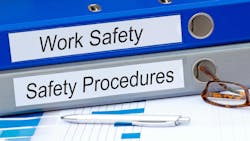Key Takeaways
- Overloading safety warnings with vague or generic information can reduce work quality and safety compliance.
- Simplifying procedures by grouping steps and removing unnecessary warnings improves technician efficiency and safety awareness.
- Targeted safety instructions (aligned with standards like NFPA 70E) promote a methodical approach that enhances safety and productivity.
- Clear, well-organized safety documentation encourages workers to read and follow procedures, reducing risks and downtime.
It is possible to have the perception of too much safety. When this perception exists, people respond in ways that increase risk. Typically, those responses also reduce work quality and job efficiency.
Examples of "too much safety" going wrong
An Ohio control systems manufacturer was bought by another company, and the new executives deemed the user manuals to have insufficient safety information. So what they did was revise the existing manuals by inserting long sections of generic safety warnings into the text.
These didn’t provide actionable safety information, and they made it hard for the user to find the technical content. These manuals went out with one of the largest orders in the company’s history. The unhappy customer demanded the manuals be revised and withheld final payment until revised manuals were received.
Fortunately, the manufacturer had copies of the original manuals and was quickly able to respond. And they got the message that cramming the text full of useless, vague warnings was a bad idea.
Creating a successful safety plan
A new plant engineer at a Kentucky plastics plant discovered that maintenance technicians were not even using the maintenance procedures. In addition to being incomprehensibly dense with all sorts of unnecessary technical information, they had the same safety warning problem mentioned previously.
Complicating matters further, a particular piece of equipment would have a single procedure that included all of the maintenance steps in no particular order. Typically, there were multiple paragraphs of wordy, incomprehensible safety warnings about electric shock before each of a series of steps.
An expert was brought in to fix the procedures used for preventive maintenance (PM) and repair. The expert:
- Grouped the steps by those that could be done with the equipment in an “electrically safe condition” [NFPA 70E, Article 120] and those that were not (because they could not be done with equipment de-energized, such as voltage measurements and vibration testing) [NFPA 70E, Article 130]. In most cases, this resulted in a non-energized procedure and an energized procedure for the same equipment. And that not only produced time-savings for maintenance but also reduced the downtime needed to do PMs. This latter benefit had the same effect as would be had if the plant added another partial shift or more production equipment. Essentially, it was free revenue.
- Added as an early step in the non-energized procedures: “Perform lockout/tagout before performing the maintenance tasks that follow.”
- Added as an early step in the energized procedures a requirement to obtain a “hot work permit”.
- Replaced some of the generic warnings with procedural steps. For example, instead of multiple paragraphs warning about the hazards of one of the plant’s main chemicals a step was added, “Coordinate with Operations to valve out the hexane supply to this equipment.” Where such a precaution wasn’t even needed, it had been mindlessly copied and pasted into just about every procedure. So the aforementioned step was added only where needed.
- Removed needless warnings. For example, a qualified maintenance electrician does not need to read three paragraphs about the danger of electrical shocks. Nor does a mechanic need to read those when his job is to change gearbox oil.
- Created a separate and continuous section listing all safety warnings that were relevant to the job being performed. These were grouped by general, electrical, and mechanical; this further saved time and reduced confusion. The maintenance techs gave this very high marks. Finally, they had something that was useful and well-organized.
Conclusion
The lazy way of larding up a procedure with copy and paste generic warnings so you can check off the box that you addressed safety does not make people any safer. It makes them see safety as something the management doesn’t really care about and that gets in the way of getting the job done. Consequently, it makes them less safe.
The correct approach includes what the expert did at that Kentucky plastics plant. The underlying concept is to promote the methodical execution of the work. This concept underlies NFPA 70E. If you look at the standard as a whole or examine any one of its articles, what you see is a methodical approach that improves both safety and efficiency.
If you are tempted to add on the generic safety warnings for good measure, don’t. Maintenance people have only so much time to complete their work, and they don’t like to spend it wading through text that doesn’t help them work safer, better, or more efficiently. You want to keep procedures lean enough that people will actually read and follow them.
About the Author

Mark Lamendola
Mark is an expert in maintenance management, having racked up an impressive track record during his time working in the field. He also has extensive knowledge of, and practical expertise with, the National Electrical Code (NEC). Through his consulting business, he provides articles and training materials on electrical topics, specializing in making difficult subjects easy to understand and focusing on the practical aspects of electrical work.
Prior to starting his own business, Mark served as the Technical Editor on EC&M for six years, worked three years in nuclear maintenance, six years as a contract project engineer/project manager, three years as a systems engineer, and three years in plant maintenance management.
Mark earned an AAS degree from Rock Valley College, a BSEET from Columbia Pacific University, and an MBA from Lake Erie College. He’s also completed several related certifications over the years and even was formerly licensed as a Master Electrician. He is a Senior Member of the IEEE and past Chairman of the Kansas City Chapters of both the IEEE and the IEEE Computer Society. Mark also served as the program director for, a board member of, and webmaster of, the Midwest Chapter of the 7x24 Exchange. He has also held memberships with the following organizations: NETA, NFPA, International Association of Webmasters, and Institute of Certified Professional Managers.
